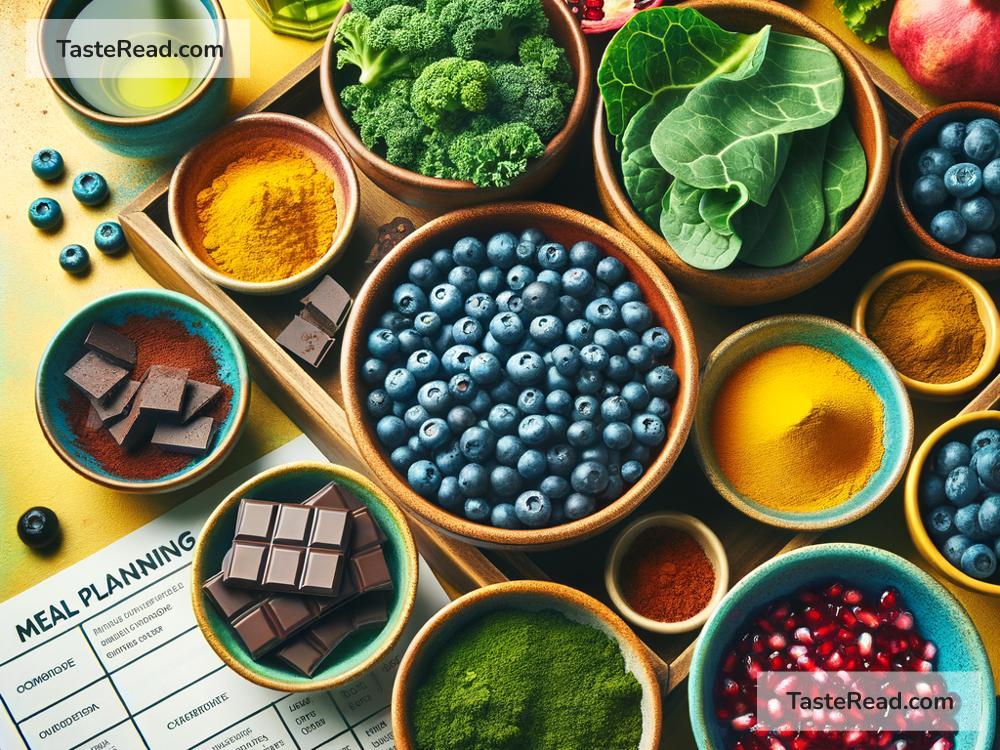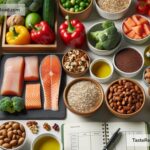How to Plan Meals for Optimal Antioxidant Intake
Antioxidants are like tiny superheroes in your body, fighting harmful molecules called free radicals that can cause damage to your cells. These free radicals can come from pollution, processed food, stress, and even natural processes in your body. Adding more antioxidants to your meals is a great way to help your body stay healthy, protect your cells, and even boost your energy levels. But how can you plan your meals to make sure you’re getting enough of them? Let’s break it down into simple steps!
What Are Antioxidants?
Before we dive into meal planning, it’s helpful to understand what antioxidants are. Antioxidants are substances found in certain foods that help protect your body from oxidative stress, which can lead to aging, inflammation, and diseases like cancer and heart disease. Common antioxidants include:
- Vitamin C (found in oranges, bell peppers, and strawberries)
- Vitamin E (found in nuts, seeds, and spinach)
- Beta-Carotene (found in carrots, sweet potatoes, and mangoes)
- Selenium (found in fish, eggs, and Brazil nuts)
- Flavonoids and Polyphenols (found in tea, dark chocolate, and berries)
In short, antioxidants are abundant in colorful fruits and vegetables, nuts, seeds, and whole grains.
Step 1: Build a Colorful Plate
A simple way to ensure you’re getting enough antioxidants in your meals is to eat a variety of colorful foods. Many antioxidants are found in fruits and vegetables that have bright colors. For example:
– Red foods like tomatoes and strawberries are rich in lycopene and vitamin C.
– Orange foods like carrots and sweet potatoes have beta-carotene.
– Green foods like kale, spinach, and broccoli are full of lutein and vitamin E.
– Purple foods like blueberries and eggplants contain anthocyanins.
When planning a meal, think about how many colors you can add to your plate. A salad with spinach, cherry tomatoes, shredded carrots, purple cabbage, and a sprinkle of nuts is a great choice for an antioxidant-packed dish!
Step 2: Focus on Whole Foods
Processed foods tend to have fewer antioxidants than whole, fresh foods. Chips, fast food, and pre-packaged meals won’t give you the same benefits as fruits, vegetables, and lean proteins. Try to plan meals that are made from scratch using fresh ingredients. For example:
– Instead of buying a box of macaroni and cheese, make your own pasta dish with whole-grain pasta, fresh tomatoes, spinach, garlic, and olive oil.
– Replace store-bought granola bars with a snack of homemade trail mix featuring nuts, seeds, and dried fruit.
Whole foods don’t just give you more antioxidants—they also provide other essential nutrients your body needs to thrive.
Step 3: Include Antioxidant-Rich Snacks
Snacks are an easy way to boost your antioxidant intake throughout the day. Instead of reaching for chips or cookies, go for these healthier options:
– A handful of mixed berries
– Raw veggies like carrot sticks or cucumber slices with hummus
– Nuts and seeds, such as almonds, walnuts, or sunflower seeds
– A small piece of dark chocolate (at least 70% cacao)
Keep antioxidant-rich snacks handy at work or home for a quick energy boost.
Step 4: Herbs and Spices Matter!
Did you know that herbs and spices are packed with antioxidants? Adding them to your meals can increase the health benefits while making your food more flavorful. For example:
– Turmeric contains curcumin, a powerful antioxidant that reduces inflammation. Add it to soups or sprinkle it on roasted veggies.
– Cinnamon is rich in polyphenols and pairs well with oatmeal, baked apples, or smoothies.
– Garlic contains sulfur compounds that fight free radicals. Use it in stir-fries, pasta sauces, or dressings.
Experiment with different herbs and spices to elevate both the taste and nutritional value of your food.
Step 5: Don’t Forget Beverages
It’s not just solid foods that contain antioxidants—what you drink matters too! Beverages like green tea, black tea, and coffee are rich in antioxidants. If you want something caffeine-free, try herbal teas made with hibiscus or rooibos. Freshly squeezed juices, especially from fruits like oranges, berries, or pomegranate, are another great option. And don’t forget water infused with lemon, cucumber, or mint for a refreshing antioxidant boost.
Step 6: Plan Ahead
The key to maintaining an antioxidant-rich diet is preparation. Take time each week to plan your meals and snacks. Start by listing antioxidant-rich foods you enjoy and building meals around them. Here’s an example meal plan:
– Breakfast: A smoothie made with spinach, frozen mixed berries, banana, and almond milk.
– Lunch: A quinoa salad with kale, roasted sweet potatoes, chickpeas, and tahini dressing.
– Dinner: Grilled salmon with steamed broccoli, red bell peppers, and brown rice.
– Snacks: A handful of almonds and a cup of green tea.
When your meals are pre-planned and packed with antioxidants, you’re more likely to stick to healthy choices.
Step 7: Balance Is Key
While antioxidants are fantastic for your health, balance is important in any diet. Make sure you’re getting enough proteins, healthy fats, and fiber, in addition to antioxidants. Combine antioxidant-rich foods with lean proteins (like chicken or fish) and whole grains (like quinoa or brown rice) to create complete, balanced meals.
Conclusion
Planning meals for optimal antioxidant intake isn’t hard—it’s about choosing colorful, whole foods, adding flavorful spices, and thinking ahead. By filling your plate with a variety of fruits, vegetables, nuts, seeds, teas, and fresh dishes, you’ll give your body the tools it needs to fight free radicals and stay strong. Small, intentional changes to your diet can make a big difference in your health over time. So, get creative in the kitchen and start enjoying the benefits of antioxidant-packed meals today!


